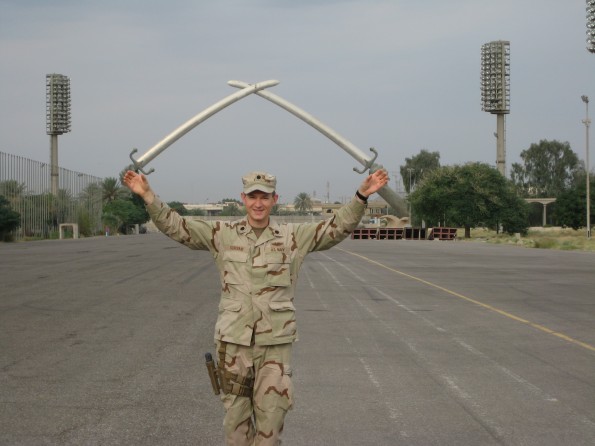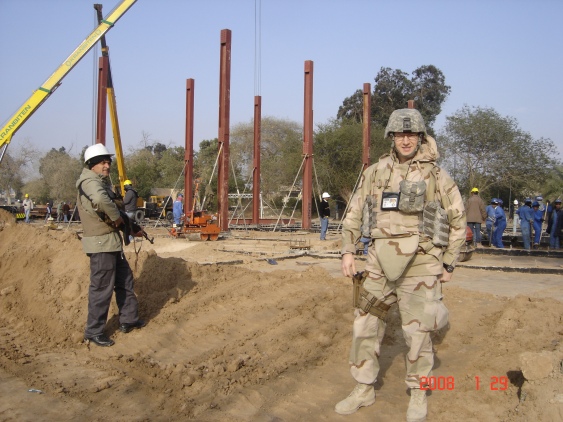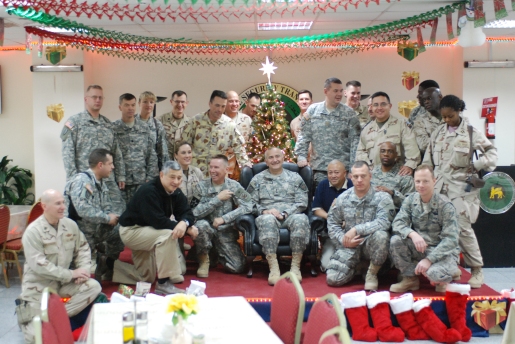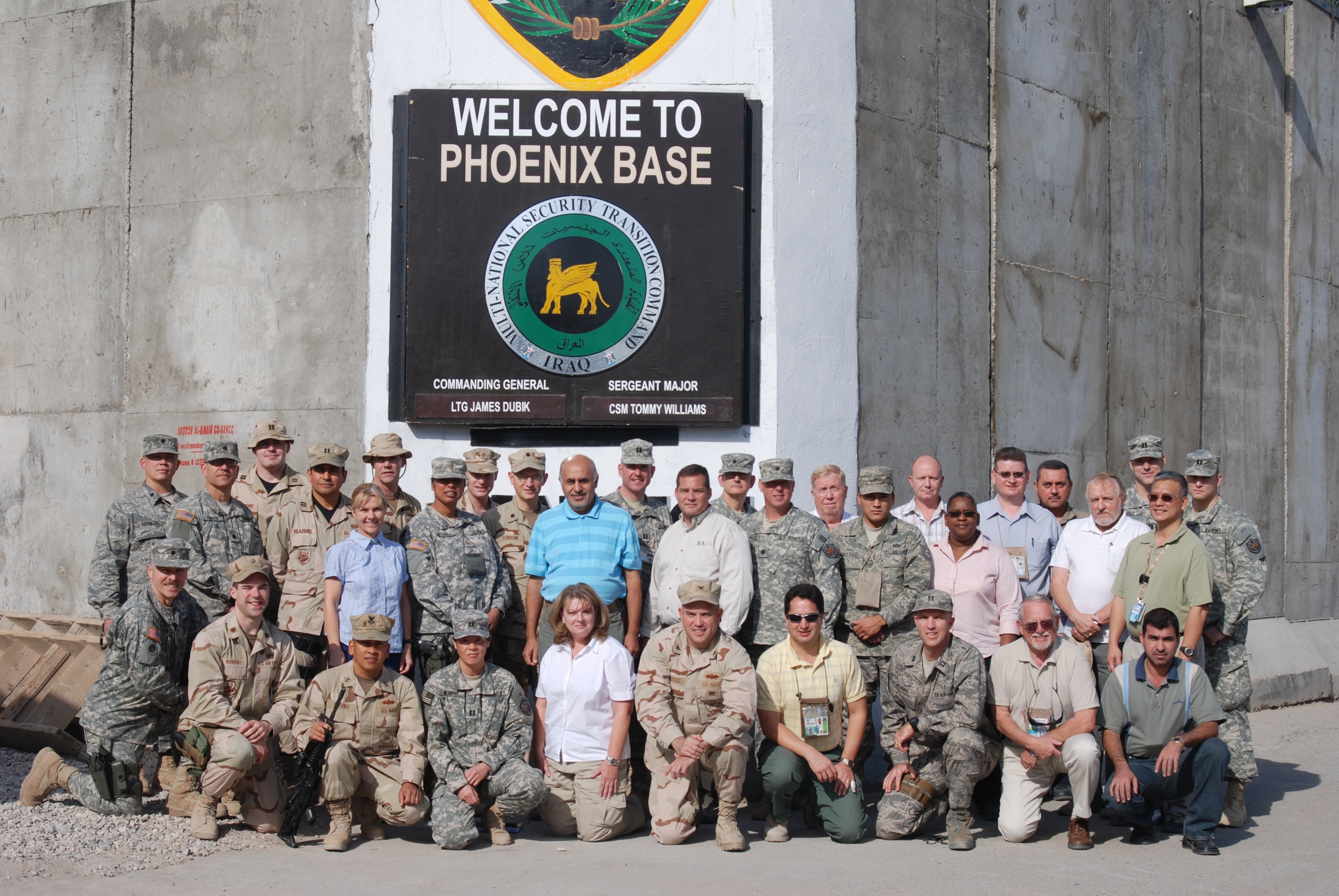The Crossed Swords monument is probably the most visited and photographed in the International Zone. The Swords of Qadissiya, also called the “Hands of Victory” or, as they are known by most, the “Crossed Swords,” are a pair of triumphal arches. Each arch consists of hands holding crossed swords, and mark the entrances to a parade ground that was constructed to commemorate Iraq’s supposed victory in the Iran-Iraq War (1980-1988).

The official name of “the Swords of Qadissiya” is an allusion to the historical Battle of al-Qadissiya in 636 A.D. (Arabic: معارك القادسيّة , Ma`ārak al-Qadissiya). Qadissiya was the decisive military engagement fought between the Arab Muslim army and the Sasanian Persian army during the first period of Islamic expansion which resulted in the Islamicization of Persia and the resurrection of Mesopotamian civilization under Islamic rule. This battle has gone down in Iraqi history as a god-given sign of Arab superiority over the Persians.
While the emotive power of the battle has been used throughout Iraqi history since, the most notable use was the dubbing by Saddām Hussein of his eight-year war against Iran as Qadissiya-Saddām (“Saddam’s Qadissiya”). The first instance of this naming occurred April 2, 1980, six months before the outbreak of hostilities, on the occasion of a visit by Saddam Hussein to al-Mustansiriyyah University in Baghdad. A bomb attack the previous day at the university had injured Saddam’s vice president, Tariq Aziz. Saddām blamed the newly-founded Islamic Republic of Iran (IRI) and, drawing the parallel to the 7th-Century battle, he announced:
“In your name, brothers, and on behalf of the Iraqis and Arabs everywhere we tell those [Persian] cowards and dwarfs who try to avenge al-Qadissiya that the spirit of al-Qadissiya as well as the blood and honor of the people of Al-Qadissiya who carried the message on their spearheads are greater than their attempts.”
The theme of Saddam leading a new Arab conquest of the Persians permeated the Iran-Iraq War. Paintings, speeches, coins, paper money, street names, poetry – all ran rife with Qadissiya themes. The freeway beginning at Oman Circle and running through the IZ’s Checkpoint 12 and beyond to Baghdad International Airport is called the “Qadissiya Expressway.”
In 1986, two years before the war’s end, the government of Iraq began the construction of a festival and parade ground in Zawra Park, near the extensive presidential complex in the center of Baghdad. Known as Grand Festivities Square, it is comprised of a large parade ground, an extensive reviewing stand and pavilion, and the two crossed-sword arches.
The Crossed Swords were the largest manifestation of Saddam’s Qadissiya theme. Iraq’s leading sculptor, Adil Kamil, was commissioned to design the arches. His design consists of a pair of massive hands emerging at 45 degree angles from the ground, each holding a 140-foot long sword. The swords were designed to be the highest triumphal arches in the world, two and half times the height of the Arc de Triomphe in Paris. The swords are modeled after the sword carried by the victorious Arab general at the Battle of al-Qadissiya . A small flagpole flying the Iraqi flag rises from the point where the swords meet – 40 meters above the street. On the swords beneath the flagpole, the Bismillah is written in raised metal lettering. Kamil used photographs of Saddam as his model for the design of the hands. When Kamil died in 1987, with the monument incomplete, his position was assumed by fellow artist Mohammad Ghani. Ghani personally took an impression of one of Saddam’s thumbs, and the resulting fingerprint was added to the mold for one of the arches’ thumbs. The arches were made by an international consortium led by the German foundry H+H Metalform and included the British company Morris Singer Founders. The guns of Iraqi soldiers – “the glorious martyrs” – killed in the Iran-Iraq war, were used to make the alloy from which the arches were cast. Each blade weighs 24 tons. As a further embellishment, the helmets of 2,500 Iranian soldiers killed during the war are held in metal nets at the base of each hand. A cursory inspection of the helmets shows many are pierced with bullet holes. Additional helmets are buried in the concrete road surface like small speed bumps so that can be continually “trampled” by vehicle and pedestrian traffic.
When Saddam inaugurated his triumphal arches on Aug. 8, 1989, he rode under them on a white horse. The choice of mount carried a triple allusion: first, to the steed of Hussein, the Shi’ia hero martyred at nearby Karbala in 680 (an admittedly odd choice for a Sunni), second, to the steed ridden by the victorious Arab general at the Battle of Qadissiya, Sa`d ibn Abī Waqqās; and third, to King Faisal I (Saddam Hussein also wore the same ceremonial attire the king wore during official state ceremonies).
The monument was not destroyed during the 1991 Gulf War, although General Norman Schwarzkopf wanted to correct that oversight during the 2003 invasion of Iraq. According to Gen. Schwartzkopf:
“I had spoken to Powell regularly throughout the day . . . .At ten p.m., I called to give him a final update. I was tired; at the end of the conversation I heard myself say how much I’d like to blow up the giant Saddam statue and the Victory Arch in downtown Baghdad. The Victory Arch, a monument to the war against Iran, was a huge sculpture of two hands, said to be Saddam’s, holding two swords crossed. We’d spared both the statue and the Victory Arch during the air campaign because they weren’t military targets. To my surprise, Powell was all for it – although he suggested we check with the President first. Pentagon lawyers vetoed the idea a couple of days later.”
The Crossed Swords have become the routine backdrop for everyone’s “Look Ma, I’m in Baghdad” photo op.
[A VISITOR’S GUIDE TO BAGHDAD’S INTERNATIONAL ZONE, By Richard H. Houghton III and Patrick J. McDonald]
Powered by ScribeFire.




